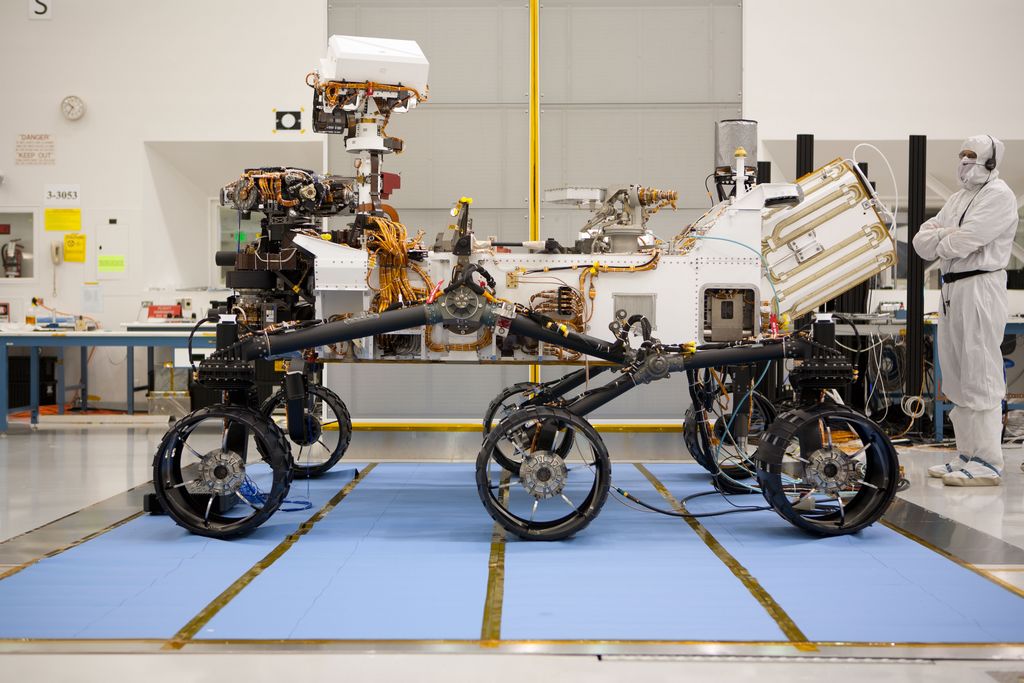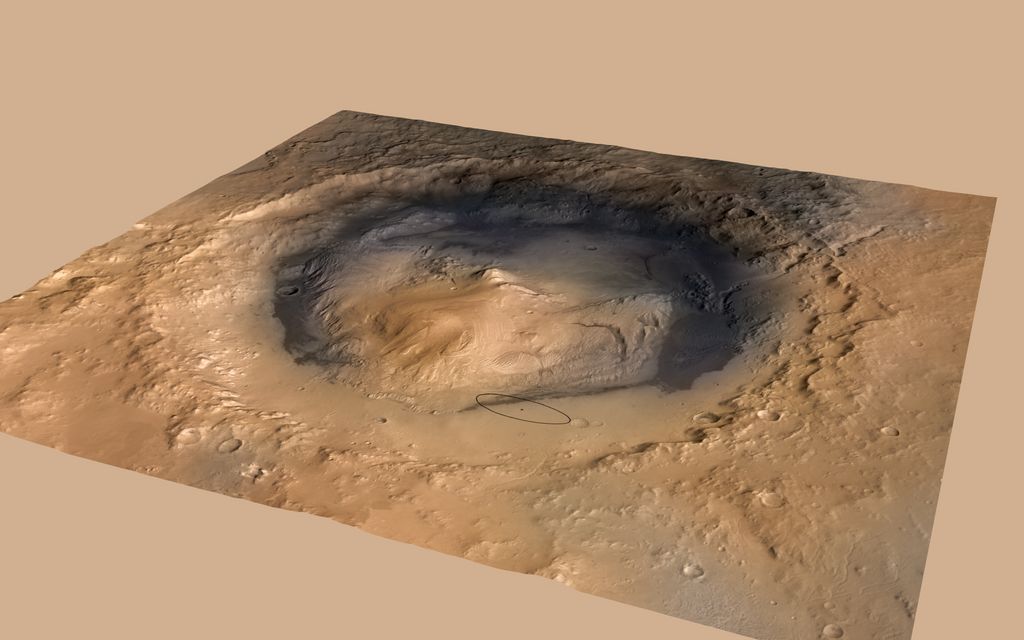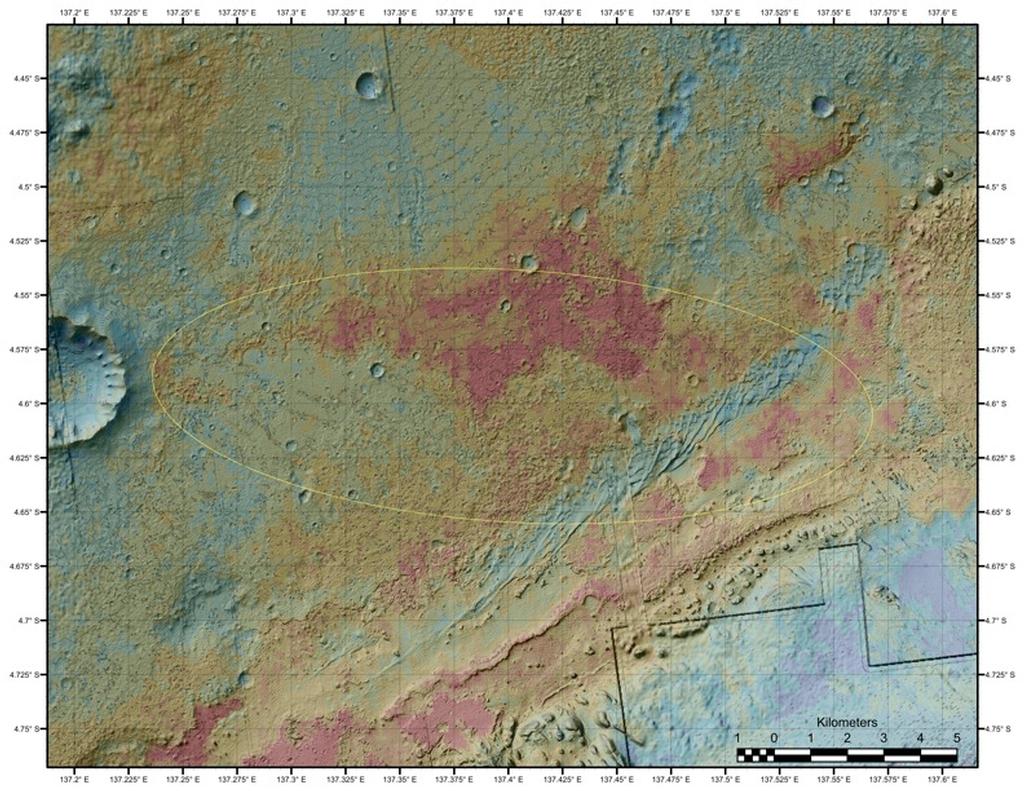NASA: Mars Mission - Mision a Marte - Curiosity the Geologist and Chemist Robot - Curiosidad. Robot geologo y quimico - Jet Propulsion Laboratory - California Institute of Technology
Posted by Ricardo Marcenaro | Posted in NASA: Mars Mission - Mision a Marte - Curiosity the Geologist and Chemist Robot - Curiosidad. Robot geologo y quimico - Jet Propulsion Laboratory - California Institute of Technology | Posted on 8:18

12.09.2011
NASA's Curiosity Rover in Profile
About the size of a small SUV, NASA's Curiosity rover is well equipped
for a tour of Gale Crater on Mars. This impressive rover has six-wheel
drive and the ability to turn in place a full 360 degrees, as well as
the agility to climb steep hills. During a nearly two-year prime mission
after landing on Mars, the rover will investigate whether Gale Crater
ever offered conditions favorable for microbial life, including the
chemical ingredients for life.
NASA's Jet Propulsion Laboratory, a division of the California Institute of Technology, Pasadena, Calif., manages the Mars Science Laboratory Project for the NASA Science Mission Directorate, Washington.
More information about Curiosity is online at: http://www.nasa.gov/msl or http://mars.jpl.nasa.gov/msl.
Image Credit: NASA/JPL-Caltech
NASA's Jet Propulsion Laboratory, a division of the California Institute of Technology, Pasadena, Calif., manages the Mars Science Laboratory Project for the NASA Science Mission Directorate, Washington.
More information about Curiosity is online at: http://www.nasa.gov/msl or http://mars.jpl.nasa.gov/msl.
Image Credit: NASA/JPL-Caltech
Mission Status Report
PASADENA, Calif. -- A maneuver on Tuesday adjusted the flight path of
NASA's Mars Science Laboratory spacecraft for delivering the rover
Curiosity to a landing target beside a Martian mountain.
The car-size, one-ton rover is bound for arrival the evening of Aug. 5,
2012, PDT (early Aug. 6, EDT and Universal Time). The landing will mark
the beginning of a two-year prime mission to investigate whether one of
the most intriguing places on Mars ever offered an environment favorable
for microbial life.
The latest trajectory correction maneuver, the third and smallest since
the Nov. 26, 2011, launch, used four thruster firings totaling just 40
seconds. Spacecraft data and Doppler-effect changes in radio signal from
the craft indicate the maneuver succeeded. As designed by engineers at
NASA's Jet Propulsion Laboratory, Pasadena, Calif., the maneuver adjusts
the location where the spacecraft will enter Mars' atmosphere by about
125 miles (200 kilometers) and advances the time of entry by about 70
seconds.
"This puts us closer to our entry target, so if any further maneuvers
are needed, I expect them to be small," said JPL's Tomas Martin-Mur, the
mission's navigation team chief. Opportunities for up to three
additional trajectory correction maneuvers are scheduled during the
final eight days of the flight.
The maneuver served both to correct errors in the flight path that
remained after earlier correction maneuvers and to carry out a decision
this month to shift the landing target about 4 miles (7 kilometers)
closer to the mountain.
It altered the spacecraft's velocity by about one-tenth of a mile per
hour (50 millimeters per second). The flight's first and second
trajectory correction maneuvers produced velocity changes about 150
times larger on Jan. 11 and about 20 times larger on March 26.
Shifting the landing target closer to the mountain, informally named
Mount Sharp, may shave months off the time needed for driving from the
touchdown location to selected destinations at exposures of
water-related minerals on the slope of the mountain.
The flight to Mars has entered its "approach phase" leading to landing
day. Mission Manager Arthur Amador of JPL said, "In the next 40 days,
the flight team will be laser-focused on the preparations for the
challenging events of landing day -- continuously tracking the
spacecraft's trajectory and monitoring the health and performance of its
onboard systems, while using NASA's Deep Space Network to stay in
continuous communications. We're in the home stretch now. The spacecraft
continues to perform very well. And the flight team is up for the
challenge."
Descent from the top of Mars' atmosphere to the surface will employ bold
techniques enabling use of a smaller target area and heavier landed
payload than were possible for any previous Mars mission. These
innovations, if successful, will place a well-equipped mobile laboratory
into a locale especially well suited for its mission of discovery. The
same innovations advance NASA toward capabilities needed for human
missions to Mars.
A video about the challenges of the landing is online at: http://go.nasa.gov/Q4b35n or http://go.usa.gov/vMn .
As of June 27, the Mars Science Laboratory spacecraft carrying the rover
Curiosity will have traveled about 307 million miles (494 million
kilometers) of its 352-million-mile (567-million-kilometer) flight to
Mars.
JPL, a division of the California Institute of Technology in Pasadena,
manages the mission for the NASA Science Mission Directorate,
Washington. More information about Curiosity is online at http://www.nasa.gov/msl.and http://mars.jpl.nasa.gov/msl/ . You can follow the mission on Facebook at: http://www.facebook.com/marscuriosity and on Twitter at: http://www.twitter.com/marscuriosity .
Guy Webster/DC Agle 818-354-6278/818-393-9011
Jet Propulsion Laboratory, Pasadena, Calif.
guy.webster@jpl.nasa.gov /agle@jpl.nasa.gov
Jet Propulsion Laboratory, Pasadena, Calif.
guy.webster@jpl.nasa.gov /agle@jpl.nasa.gov

Drive the robot - Maneje el robot:
Curiosity - Robot Geologist and Chemist in One!
This artist's concept features NASA's Mars Science Laboratory Curiosity rover, a mobile robot for investigating Mars' past or present ability to sustain microbial life.Curiosity will land near the Martian equator about 10:31 p.m., Aug. 5 PDT (1:31 a.m. Aug. 6 EDT).
In this picture, the rover examines a rock on Mars with a set of tools at the end of the rover's arm, which extends about 7 feet (2 meters). Two instruments on the arm can study rocks up close. A drill can collect sample material from inside of rocks and a scoop can pick up samples of soil. The arm can sieve the samples and deliver fine powder to instruments inside the rover for thorough analysis.
The mast, or rover's "head," rises to about 6.9 feet (2.1 meters) above ground level, about as tall as a basketball player. This mast supports two remote-sensing science instruments: the Mast Camera, or "eyes," for stereo color viewing of surrounding terrain and material collected by the arm; and, the Chemistry and Camera instrument, which uses a laser to vaporize a speck of material on rocks up to about 23 feet (7 meters) away and determines what elements the rocks are made of.
NASA's Jet Propulsion Laboratory, a division of the California Institute of Technology, Pasadena, manages the Mars Science Laboratory Project for the NASA Science Mission Directorate, Washington.
For more information about Curiosity is at http://www.nasa.gov/msl and http://mars.jpl.nasa.gov/msl/ .
Image credit: NASA/JPL-Caltech
Martian Dune Buggy - July 03, 2012
NASA engineers take the Curiosity test rover to California's Mojave desert to learn how to drive on Martian sand dunes.
NASA engineers take the Curiosity test rover to California's Mojave desert to learn how to drive on Martian sand dunes.

06.11.2012
Altered Landing Target in Gale Crater, Mars
As of June 2012, the target landing area for NASA's Mars Science
Laboratory mission is the ellipse marked on this image of Gale Crater.
The ellipse is about 12 miles long and 4 miles wide (20 kilometers by 7
kilometers). The diameter of Gale Crater is 96 miles (154 kilometers).
If landing goes well, the mission's rover, Curiosity, will drive in
subsequent months to science destinations on Mount Sharp, outside of the
landing ellipse.
A reduction in the size of the ellipse in June 2012 was based on analysis yielding increasing confidence in the precision capabilities of the mission's system for getting from the top of the Martian atmosphere to the surface. Using the smaller ellipse, the Mars Science Laboratory Project also moved the center of the target closer to Mount Sharp, which holds geological layers that are the prime destinations for the rover. Landing will be the evening of Aug. 5, 2012, Pacific Daylight Time (early Aug. 6 Universal Time and Eastern Time).
This oblique view of Mount Sharp is derived from a combination of elevation and imaging data from three Mars orbiters. The view is looking toward the southeast. Mount Sharp rises about 3.4 miles (5.5 kilometers) above the floor of Gale Crater.
The image combines elevation data from the High Resolution Stereo Camera on the European Space Agency's Mars Express orbiter, image data from the Context Camera on NASA's Mars Reconnaissance Orbiter, and color information from Viking Orbiter imagery. There is no vertical exaggeration in the image.
NASA's Jet Propulsion Laboratory, a division of the California Institute of Technology, Pasadena, manages the Mars Science Laboratory mission for the NASA Science Mission Directorate, Washington.
Image Credit: NASA/JPL-Caltech/ESA/DLR/FU Berlin/MSSS
A reduction in the size of the ellipse in June 2012 was based on analysis yielding increasing confidence in the precision capabilities of the mission's system for getting from the top of the Martian atmosphere to the surface. Using the smaller ellipse, the Mars Science Laboratory Project also moved the center of the target closer to Mount Sharp, which holds geological layers that are the prime destinations for the rover. Landing will be the evening of Aug. 5, 2012, Pacific Daylight Time (early Aug. 6 Universal Time and Eastern Time).
This oblique view of Mount Sharp is derived from a combination of elevation and imaging data from three Mars orbiters. The view is looking toward the southeast. Mount Sharp rises about 3.4 miles (5.5 kilometers) above the floor of Gale Crater.
The image combines elevation data from the High Resolution Stereo Camera on the European Space Agency's Mars Express orbiter, image data from the Context Camera on NASA's Mars Reconnaissance Orbiter, and color information from Viking Orbiter imagery. There is no vertical exaggeration in the image.
NASA's Jet Propulsion Laboratory, a division of the California Institute of Technology, Pasadena, manages the Mars Science Laboratory mission for the NASA Science Mission Directorate, Washington.
Image Credit: NASA/JPL-Caltech/ESA/DLR/FU Berlin/MSSS

07.16.2012
Geological Diversity at Curiosity's Landing Site
The area where NASA's Curiosity rover will land on Aug. 5 PDT (Aug. 6
EDT) has a geological diversity that scientists are eager to
investigate, as seen in this false-color map based on data from NASA's
Mars Odyssey orbiter. The image was obtained by Odyssey's Thermal
Emission Imaging System. It merges topographical data with thermal
inertia data that record the ability of the surface to hold onto heat.
The yellow oval shows the elliptical landing target for Curiosity's landing site.
An alluvial fan is visible around a crater to the northwest of the landing area. A series of undulating lines traveling southeast from the crater indicates similar material moving down a slope. The material, which appears bluish-green in this image, also forms a fan shape.
An area in red indicates a surface material that is more tightly cemented together than rocks around it and likely has a high concentration of minerals. An attractive interpretation for this texture is that water could have been present there some time in the past.
Curiosity is expected to land within the large Gale Crater. The rim of a smaller crater (about a half mile, or 1 kilometer, in diameter) inside of Gale is visible at the bottom right of the image.
NASA's Jet Propulsion Laboratory manages the 2001 Mars Odyssey mission for NASA's Science Mission Directorate, Washington, D.C. The Thermal Emission Imaging System (THEMIS) was developed by Arizona State University, Tempe, in collaboration with Raytheon Santa Barbara Remote Sensing. The THEMIS investigation is led by Dr. Philip Christensen at Arizona State University. Lockheed Martin Astronautics, Denver, is the prime contractor for the Odyssey project, and developed and built the orbiter. Mission operations are conducted jointly from Lockheed Martin and from JPL, a division of the California Institute of Technology in Pasadena.
Image Credit: NASA/JPL-Caltech
The yellow oval shows the elliptical landing target for Curiosity's landing site.
An alluvial fan is visible around a crater to the northwest of the landing area. A series of undulating lines traveling southeast from the crater indicates similar material moving down a slope. The material, which appears bluish-green in this image, also forms a fan shape.
An area in red indicates a surface material that is more tightly cemented together than rocks around it and likely has a high concentration of minerals. An attractive interpretation for this texture is that water could have been present there some time in the past.
Curiosity is expected to land within the large Gale Crater. The rim of a smaller crater (about a half mile, or 1 kilometer, in diameter) inside of Gale is visible at the bottom right of the image.
NASA's Jet Propulsion Laboratory manages the 2001 Mars Odyssey mission for NASA's Science Mission Directorate, Washington, D.C. The Thermal Emission Imaging System (THEMIS) was developed by Arizona State University, Tempe, in collaboration with Raytheon Santa Barbara Remote Sensing. The THEMIS investigation is led by Dr. Philip Christensen at Arizona State University. Lockheed Martin Astronautics, Denver, is the prime contractor for the Odyssey project, and developed and built the orbiter. Mission operations are conducted jointly from Lockheed Martin and from JPL, a division of the California Institute of Technology in Pasadena.
Image Credit: NASA/JPL-Caltech
NASA: Mars Mission - Mision a Marte - Curiosity the Geologist and Chemist Robot - Curiosidad. Robot geologo y quimico - Jet Propulsion Laboratory - California Institute of Technology
Ricardo M Marcenaro - Facebook
Operative blogs of The Solitary Dog:
solitary dog sculptor:
http://byricardomarcenaro.blogspot.com
Solitary Dog Sculptor I:
http://byricardomarcenaroi.blogspot.com
Para:
comunicarse conmigo,
enviar materiales para publicar,
propuestas:
marcenaroescultor@gmail.com
For:
contact me,
submit materials for publication,
proposals:
marcenaroescultor@gmail.com
Diario La Nación
Argentina
Cuenta Comentarista en el Foro:
Capiscum
My blogs are an open house to all cultures, religions and countries. Be a follower if you like it, with this action you are building a new culture of tolerance, open mind and heart for peace, love and human respect.
Thanks :)
Mis blogs son una casa abierta a todas las culturas, religiones y países. Se un seguidor si quieres, con esta acción usted está construyendo una nueva cultura de la tolerancia, la mente y el corazón abiertos para la paz, el amor y el respeto humano.
Gracias :)


Comments (0)
Publicar un comentario